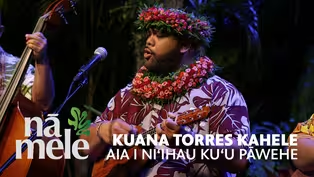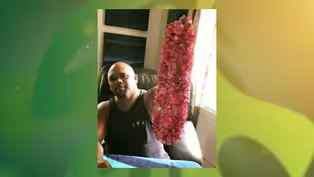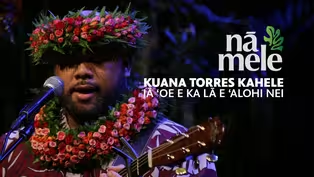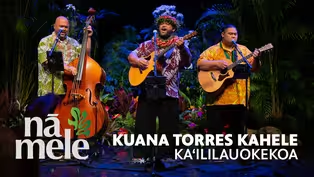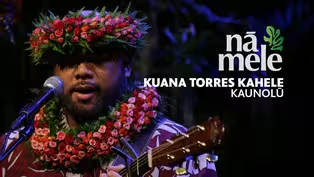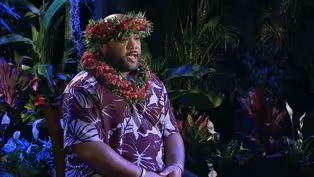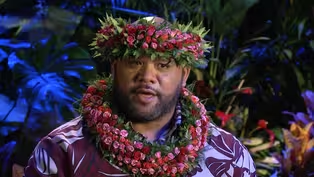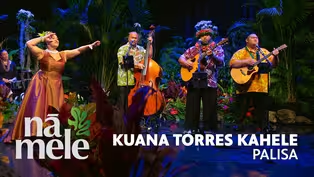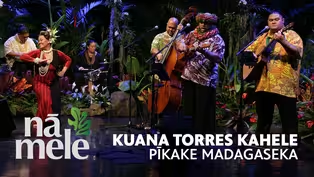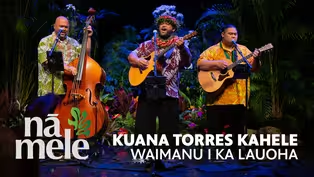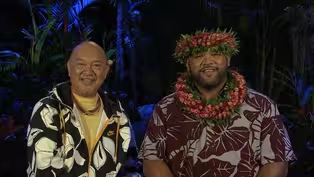
Kuana Torres Kahele
Special | 29m 44sVideo has Closed Captions
According to Kuana Torres Kahele, music can transcend boundaries.
According to Kuana Torres Kahele, music can transcend boundaries. He hopes that Hawaiian songs, or mele, can spark something inside of listeners, no matter their culture. Enjoy this new episode of Nā Mele and our digital exclusive content.
Problems playing video? | Closed Captioning Feedback
Problems playing video? | Closed Captioning Feedback
Nā Mele is a local public television program presented by PBS Hawai'i

Kuana Torres Kahele
Special | 29m 44sVideo has Closed Captions
According to Kuana Torres Kahele, music can transcend boundaries. He hopes that Hawaiian songs, or mele, can spark something inside of listeners, no matter their culture. Enjoy this new episode of Nā Mele and our digital exclusive content.
Problems playing video? | Closed Captioning Feedback
How to Watch Nā Mele
Nā Mele is available to stream on pbs.org and the free PBS App, available on iPhone, Apple TV, Android TV, Android smartphones, Amazon Fire TV, Amazon Fire Tablet, Roku, Samsung Smart TV, and Vizio.
Kuana Torres Nā Mele Digital Transcript Māka‘ika‘i really means to go from place to place, from city to city, from house to house, from ‘aina to ‘aina, and you just go, it's, it’s to journey and visit different places, and, and that's what I wanted to do via the mele, is to take everybody on a journey.
Palisa aku nei au He nani lua ʻole i kuʻu maka Kūmaka i ka mamao, he wehi haʻaheo Haʻaheo nō ka halekuʻi aʻo ke aloha He moʻolelo kaulana no Lusia me Palani Ka ʻoumuamua nui o ka ho ʻāuhuli ʻana Naue kaua ka hunalewa o nā pākaukani Nou e ke aliʻi o ka lāhui Ka ʻemepela nui lā ʻo Napoleona Palisa aku nei au He nani lua ʻole i kuʻu maka Kūmaka i ka mamao, he wehi haʻaheo Haʻaheo nō ka halekuʻi aʻo ke aloha Hiaʻai ka manaʻo ke ʻike aku I ka nani o ka piʻo o ka lanakila Kūmaka ka ʻikena i ka haʻalilo Ka nohona o ka wahine o kuʻu aloha Ka wahine aualiʻi o Mona Lisa Palisa aku nei au He nani lua ʻole i kuʻu maka Kūmaka i ka mamao, he wehi haʻaheo Haʻaheo nō ka halekuʻi aʻo ke aloha He kalaunu ʻalohi mau loa Hulali nā momi me nā kaimana Kamahoi, kamahaʻo ke nānā aku Kohu me he wai lā e ʻale mai ana He wehi hiwahiwa lā no Lui Vikona Palisa aku nei au He nani lua ʻole i kuʻu maka Kūmaka i ka mamao, he wehi haʻaheo Haʻaheo nō ka halekuʻi aʻo ke aloha Haʻaheo nō ka halekuʻi aʻo ke aloha Hawaiian music, it makes me feel so many things.
It helps me to remind me of the places that I, I've lived, the, the place that I come from.
It reminds me of home, it reminds me of family, it allows me to tell stories, it, it allows me to teach.
It allows me to do so much things, and it also does so much for me.
He mea nui noʻu ka ʻāina laʻahia ʻO Kaunolū, he ʻāina oneʻula i ka ʻae kai ʻIke ʻia ʻo Halulu i ke alo o Pali Kaholo Me ke koʻa aʻo Kūnihi ma ʻō aku i Kāneʻāpua Kaulana kauhale o Kamehameha A me ka hale o Nahiʻenaʻena Kiʻekiʻe Kaihālulu i ka ehu o ke kai Me ka wai ʻawaʻawa o ka lua wai aʻo Pāʻao He keiki wiwo ʻole ʻo Puhikapu Ka hua a Līloa me ʻAkahikuleana o Hawaiʻi Kaulana kauhale o Kamehameha A me ka hale o Nahiʻenaʻena ʻO Kolomikimiki ka pā hī aku o ke kai Ka mea hoʻīlina o Mākālei o Kaʻelehuluhulu Haʻina ʻia mai ana ka puana Lei ana Kaunolū i ka lei Puakala o ke kula Kaulana kauhale o Kamehameha A me ka hale o Nahiʻenaʻena A me ka hale o Nahiʻenaʻena Waimanu I Ka Lauoha was written to help my family, my siblings, my nieces, my nephew, all my family to help them remember where they come from, who the ‘ohana is, who are the bloodlines.
It has actually brought the ‘ohana closer, it has helped us find family members that we never met before.
And so even, uh, Tehani Kealamailani Gonzado, who will be dancing this song, uh, this is how we found out we were related, was through this song.
Kūmaka iā Waimanu Mai ka lapa aʻo Muliwai Kūmaka iā Waimanu Mai ka lapa aʻo Muliwai ʻO Waihīlau i ka pali loa Aia nō ka wai ola a Kāne Pāhihi mai ʻo Waiʻilikahi Ka i hānai iā Ka ʻohimaunu Kū māʻohe ohe ka wauke ʻA ʻohe puʻu, ʻa ʻohe keʻe A ʻea ʻe mohala i luna O ke kukui o Māhoe E lei nō au i ko aloha I ka moena ʻana o ka ʻāina ʻO Waipiʻo paoa i ke ʻala ʻĀina ulupō me ka hāloa Noho mai ka hale o Riroa I ka maka o Pakaʻalana Pā ʻeliʻeli ʻo Kānekoa Haiwā ka huli aʻo Wahine Hāliu au i ke āukauka He ʻāina wehi ohaoha Puana mai ka moʻolelo ʻO Waimanu i ka lauoha You never really know when something's gonna spark something within yourself.
And so I can be just washing clothes, outside cleaning the yard, and then boom, uh, the wind gon' blow, and it'll carry a fragrance, or I'll turn to the left, and I'll see a flower but this flower is shaped differently, and the color is different.
And it sparks something.
And immediately, it's, it's just a, it triggers something.
And it's this cascade of events that leads up to the birth of a new song.
And so that happens more often than not, and I, I notice that the older I get, the more those kind of things happen.
Na wai e ʻole ka hoʻohihi ʻO ka heʻe ʻana i Makaiwa Aia ma ke kai o Waipouli Ka home noho aʻo ka wahine He aha ia mea hoehoe?
ʻO ke kani paha a ka hano ihu?
Puhi ʻohe ʻo Kauakahi Ma ke kīʻohuʻohu ʻo Pīhanakalani ʻO ka pilina a kāua E kuʻu ipo, e Kaʻililauokekoa ē Halihali ʻia aku nō ka hana aloha Iā Kaʻililauokekoa A piʻi ʻo ia i ke kualapa keʻele O ke Kuamoʻoloaākāne Hāliu i ka moloalo a ka loko iʻa Lako nō a lawa pono Halakau ka ʻāuna manu o Kauakahi I ka hale kini lehua ʻO ka pilina a kāua E kuʻu ipo, e Kaʻililauokekoa ē e Kaʻililauokekoa ē e Kaʻililauokekoa ē So, the whole pilina, or relationship between hula and mele, it goes back hundreds and hundreds of years.
We never wrote anything down.
We never have anything to write with to begin with, in old Hawaiʻi.
And so that's where mele comes in, and mele served a purpose to remember important events in Hawai‘i, whether if it was something that happened, uh, something with the ‘ohana, something with the land, something in nature, they would document all of this through mele.
And some of the mele were often set to motion to help us also remember not, not just verbally, but visually as well.
Aia i Niʻihau kuʻu pāwehe Ka moena i pāheʻe a i kuʻu ʻili Aia i Niʻihau kuʻu pāwehe Ka moena i pāheʻe a i kuʻu ʻili Hana noʻeau a ka mikioi Ka makani nowelo piko o Lehua Hana noʻeau a ka mikioi Ka makani nowelo piko o Lehua ʻElua māua me ke ʻala Me ka ulu hua noho i ka hāpapa ʻElua māua me ke ʻala Me ka ulu hua noho i ka hāpapa Kau aku ka maka e ʻike maka I ke kō ʻeli lima o Hālāliʻi Kau aku ka maka e ʻike maka I ke kō ʻeli lima o Hālāliʻi ʻAilana ʻo Kaʻula home o nā manu A ka nāulu e hoʻoipo nei ʻAilana ʻo Kaʻula home o nā manu A ka nāulu e hoʻoipo nei Haʻina ʻia mai ana ka puana Aia i Niʻihau kuʻu pāwehe Haʻina ʻia mai ana ka puana Aia i Niʻihau kuʻu pāwehe I would hope that Hawaiian music would reach far enough to put a seed into the listener.
And what that seed grows into can be a million things.
It could take you in a direction of music, it can take you down a direction of hula, it can take you into the direction of working on the ‘aina and working for the family and, you know, kupuna and all of that kind of stuff, but the seed is Hawaiian.
That's the thing, and you don't have to be Hawaiian to receive that.
Nani wale nō ʻoe Kuʻu pua onaona ʻeā Ka pīkake anuhea O Madagaseka Nani wale nō ʻoe Kuʻu pua onaona ʻeā Ka pīkake anuhea O Madagaseka Hoʻohihi ka manaʻo Me nā pua kohu hīnano ʻeā Kui ʻia i ka poe Me ke aloha He lei ʻāʻī ʻoe Wili ʻia i ke Alaʻeli ʻeā Nolu pē i ke ʻala E moani nei ʻO ʻoe ke koʻiʻi Koi mau o loko ʻeā Lovely blossom onaona A ka puʻuwai Haʻina ʻia mai Ana ka puana ʻeā Ka pīkake anuhea O Madagaseka Haʻina ʻia mai Ana ka puana ʻeā Ka pīkake anuhea O Madagaseka All I set out to do when I was younger, I've done, and actually, I'm still doing it.
If you're an aspiring Hawaiian musician, or kumu hula, or anywhere along those lines, it's a lifelong investment.
Even if you're just a lei-maker, you don't just make lei today and move on.
You do that for life, forever, it’s a part of you.
Music is the same thing.
Hula is the same thing.
Teaching hula, teaching music, teaching Hawaiian crafts, teaching mea Hawai‘i, all of that is lifelong commitments.
I give a lei To you my dear Aloha wau ia ʻoe One lei, one kiss One love I miss Aloha wau ia ʻoe Lei of love I give to you How I miss you so I give a lei To you my dear Aloha wau ia ʻoe Lei of love I give to you How I miss you so I give a lei To you my dear Aloha wau ia ʻoe Aloha wau ia ʻoe This program was made possible by the Corporation for Public Broadcasting.
And by contributions to your PBS station from viewers like you.
Thank you.
I hope you enjoyed this episode of Nā Mele.
Programs on PBS Hawaiʻi rely on viewers like you for support.
Help keep the music playing with a donation at pbshawaii.org.
Mahalo.
Kuana Torres Kahele - Aia I Niʻihau Kuʻu Pāwehe
Video has Closed Captions
Clip: Special | 3m 20s | A song about a type of moena produced on the island of Ni‘ihau. (3m 20s)
Kuana Torres Kahele - How Kuana Learned To Make Lei
Clip: Special | 2m 25s | Kuana Torres Kahele tells the story of how and why he learned to make lei. (2m 25s)
Kuana Torres Kahele - Iā ʻOe E Ka Lā E ʻAlohi Nei
Video has Closed Captions
Clip: Special | 5m 4s | Originally written as a chant, Iā ʻOe E Ka Lā E ʻAlohi Nei honors King Kalākaua. (5m 4s)
Kuana Torres Kahele - Kaʻililauokekoa
Video has Closed Captions
Clip: Special | 4m 31s | A song about the love story between Kaʻililauokekoa and Kauakahi. (4m 31s)
Video has Closed Captions
Clip: Special | 4m 30s | Kaunolū is a place on Lanaʻi that is filled with moʻolelo about Kamehameha. (4m 30s)
Kuana Torres Kahele - Kuana on Composing New Music
Clip: Special | 37s | Kuana Torres Kahele speaks about his feelings when composing and releasing original music. (37s)
Kuana Torres Kahele - Kuana on Nature
Clip: Special | 44s | Kuana talks about the importance of nature as a singer and composer of Hawaiian music. (44s)
Kuana Torres Kahele - Kuana on Telling The Story
Clip: Special | 40s | Kuana explains how Hawaiian music is more than just a song and a melody. (40s)
Video has Closed Captions
Clip: Special | 6m 48s | Inspired by a trip to Paris, Palisa talks about the culture and history of France. (6m 48s)
Kuana Torres Kahele - Pīkake Madagaseka
Video has Closed Captions
Clip: Special | 4m 51s | An original composition inspired by the stephanotis flower, or "Madagascarian Jasmine". (4m 51s)
Kuana Torres Kahele - Waimanu I Ka Lauoha
Video has Closed Captions
Clip: Special | 5m 8s | A song composed by Kuana, dedicated to his family and where they come from. (5m 8s)
Song Challenge: Kuana Torres Kahele and Robert Cazimero
Clip: Special | 5m 56s | Kuana Torres Kahele and Robert Cazimero step up to the PBS Hawaiʻi Song Challenge. (5m 56s)
Providing Support for PBS.org
Learn Moreabout PBS online sponsorshipSupport for PBS provided by:
Nā Mele is a local public television program presented by PBS Hawai'i
